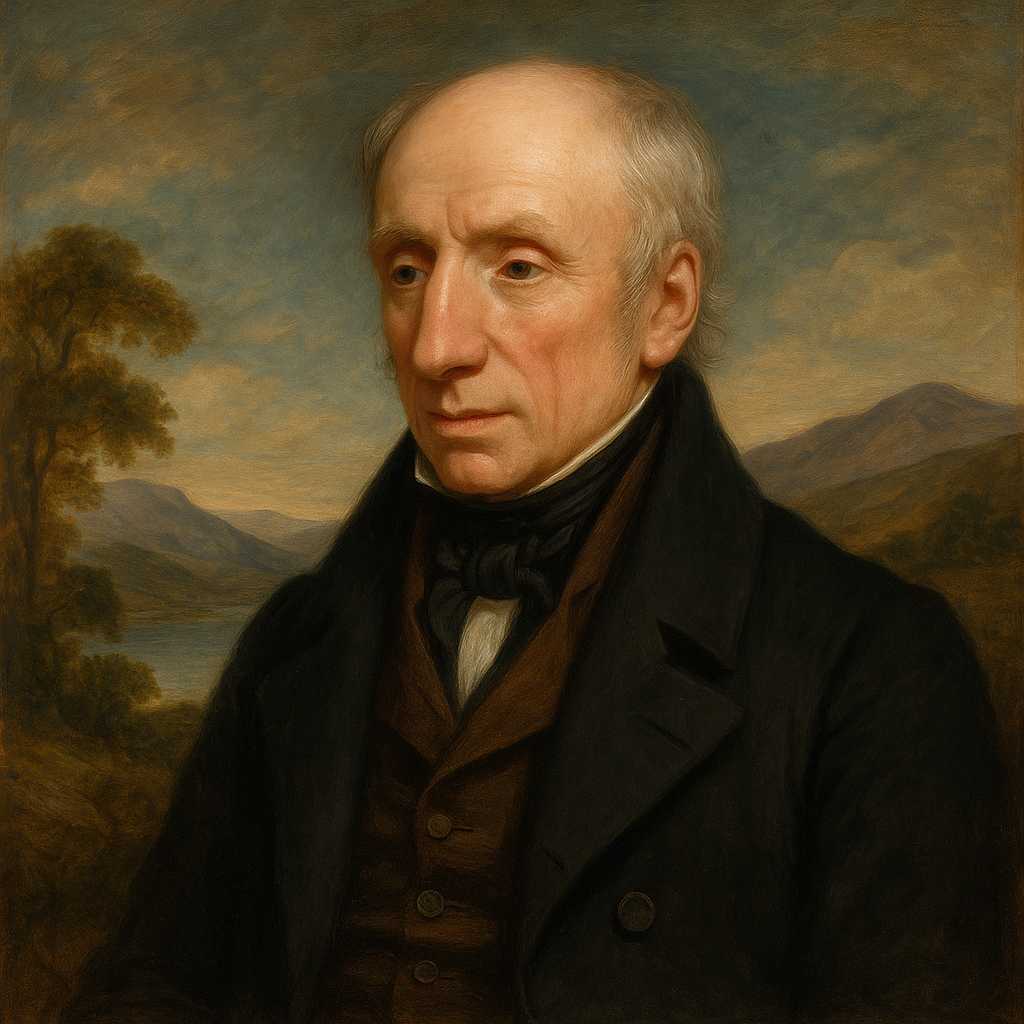Lines written near Richmond, upon the Thames, at Evening
William Wordsworth
1770 to 1850

How rich the wave, in front, imprest
With evening-twilight's summer hues,
While, facing thus the crimson west,
The boat her silent path pursues!
And see how dark the backward stream,
A little moment past so smiling!
And still perhaps, with faithless gleam,
Some other loiterer beguiling.
Such views the youthful bard allure;
But heedless of the following gloom,
He deems their colours shall endure
Till peace go with him to the tomb.
--And let him nurse his fond deceit,
And what if he must die in sorrow!
Who would not cherish dreams so sweet,
Though grief and pain may come to-morrow?
Glide gently, thus for ever glide,
O Thames! that other bards may see,
As lovely visions by thy side
As now, fair river! come to me.
O glide, fair stream! for ever so,
Thy quiet soul on all bestowing,
Till all our minds for ever flow
As thy deep waters now are flowing.
Vain thought! Yet be as now thou art,
That in thy waters may be seen
The image of a poet's heart,
How bright, how solemn, how serene!
Such heart did once the poet bless,
Who, pouring here a later ditty,
Could find no refuge from distress
Save in the milder grief of pity.
Remembrance! as we glide along,
For him suspend the dashing oar,
And pray that never child of Song
May know his freezing sorrows more.
How calm! how still! the only sound,
The dripping of the oar suspended!
The evening darkness gathers round
By virtue’s holiest powers attended.
William Wordsworth's Lines written near Richmond, upon the Thames, at Evening
William Wordsworth’s poem Lines written near Richmond, upon the Thames, at Evening embodies many of the quintessential traits of Romantic poetry, including a reverence for nature, an introspective melancholy, and a focus on the emotional and spiritual resonance of the natural world. The poem, with its serene imagery and reflective tone, juxtaposes transient beauty with the inevitability of sorrow, offering a poignant meditation on the human condition and the role of the poet. This analysis will examine the poem’s structure, themes, and literary devices to elucidate its deeper meanings.
Themes and Structure
The poem is structured into five stanzas of varying lengths, reflecting an organic flow that mirrors the Thames River itself. Thematic undercurrents include:
- Ephemerality of Beauty: Wordsworth contrasts the "rich" hues of evening twilight with the "faithless gleam" of fading light, symbolizing the transitory nature of beauty and joy.
- Youthful Idealism vs. Mature Realization: The poet critiques youthful optimism, suggesting that such dreams, though sweet, are inevitably shadowed by sorrow and grief.
- Nature as Reflection of the Poet’s Heart: The river, serene and flowing, becomes a metaphor for the poet's inner world—a site of calm and reflection, yet also a repository for grief.
- Artistic Legacy and Human Connection: Wordsworth invokes the memory of another poet (likely Thomas Chatterton or another Romantic predecessor), emphasizing the universality of poetic struggles.
Line-by-Line Analysis
Stanza 1: An Evening Scene
How rich the wave, in front, imprest
With evening-twilight's summer hues,
The opening lines immediately immerse the reader in the vivid beauty of the evening, with the river bathed in twilight hues. The word "imprest" (impressed) suggests a sense of permanence, though this impression is quickly undermined by the fleeting nature of twilight.
While, facing thus the crimson west,
The boat her silent path pursues!
The imagery of a boat quietly gliding emphasizes tranquility and motion. The westward orientation symbolizes an ending, both of the day and perhaps of life’s youthful dreams.
And see how dark the backward stream,
A little moment past so smiling!
Here, Wordsworth introduces the notion of change and loss. The backward stream, now dark, contrasts sharply with its earlier "smiling" state, underscoring the ephemerality of joy and beauty.
Stanza 2: Youthful Optimism
Such views the youthful bard allure;
But heedless of the following gloom,
Wordsworth critiques the naive optimism of youth, whose poetic imagination clings to beauty while ignoring the inevitable "gloom" that follows.
And let him nurse his fond deceit,
And what if he must die in sorrow!
The poet’s tone here is bittersweet. While acknowledging the "deceit" of youthful idealism, Wordsworth does not wholly condemn it; instead, he advocates for cherishing such dreams, even at the cost of eventual sorrow.
Stanza 3: Prayer for the Thames
Glide gently, thus for ever glide,
O Thames! that other bards may see,
This stanza transitions to a prayer-like invocation to the Thames, celebrating its timeless serenity. The repetition of "glide" creates a lulling, rhythmic effect, mirroring the river’s gentle motion.
O glide, fair stream! for ever so,
Thy quiet soul on all bestowing,
The river is personified as possessing a "quiet soul," its flow symbolizing the unceasing passage of time and the transmission of inspiration to future generations of poets.
Stanza 4: The Poet’s Reflection
That in thy waters may be seen
The image of a poet's heart,
The Thames becomes a metaphor for the poet’s own emotional state. Its reflective surface symbolizes introspection, and its serene yet solemn qualities evoke the ideal Romantic heart.
Such heart did once the poet bless,
Who, pouring here a later ditty,
Wordsworth introduces a note of elegy, likely referencing another poet who found solace or inspiration along the Thames. The “milder grief of pity” suggests an acceptance of sorrow as a softer, less destructive form of emotion.
Stanza 5: A Call to Remembrance
For him suspend the dashing oar,
And pray that never child of Song
May know his freezing sorrows more.
The poem concludes with an explicit appeal for remembrance and compassion. The “freezing sorrows” evoke a deep sense of isolation and suffering, contrasting with the warmth and vitality of the earlier twilight imagery.
How calm! how still! the only sound,
The dripping of the oar suspended!
The final image is one of profound stillness, emphasizing the meditative and solemn tone. The act of suspending the oar symbolizes a pause for reflection, urging both the poet and reader to consider the ephemeral yet impactful nature of life and art.
Conclusion
Lines written near Richmond, upon the Thames, at Evening captures the duality of human experience: the transient beauty of nature juxtaposed with the inevitability of sorrow. Wordsworth’s use of vivid imagery, personification, and metaphor invites the reader into a contemplative space, where the Thames becomes both a literal and symbolic current of inspiration and memory. Ultimately, the poem affirms the enduring power of poetic dreams and the solace found in the natural world, even amidst life’s uncertainties.
This text was generated by AI and is for reference only. Learn more
Want to join the discussion? Reopen or create a unique username to comment. No personal details required!



Comments
No comments yet. Be the first to comment!